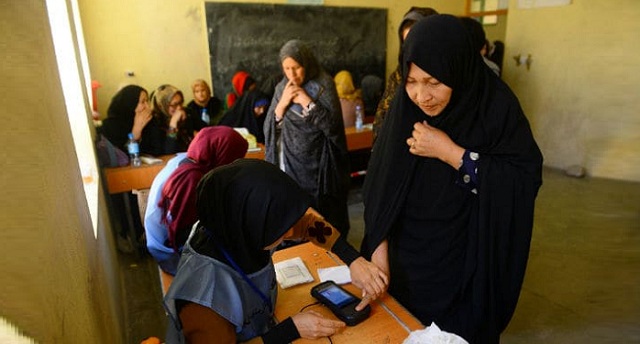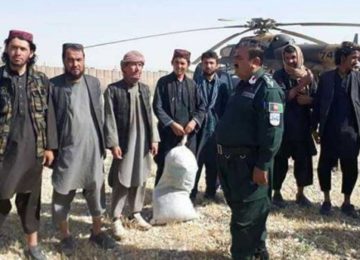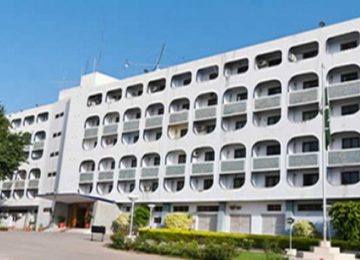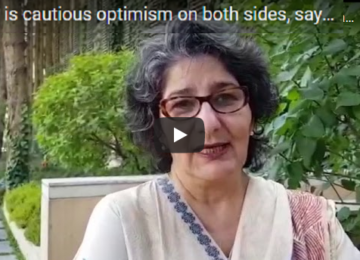October 21, 2018
The second day of the Afghan parliamentary election has been as chaotic as the first. Because many polling centres failed to open or opened late on Saturday, the Independent Election Commission (IEC) ruled that some could also open today. However, only some actually opened today and voters were presented with the same bureaucratic and technical difficulties as yesterday. It is difficult, overall, to feel confident about the statistics the IEC has given, and it has already come under scathing criticism from the Election Complaints Commission about its management of the election. Yet none of this, reports Jelena Bjelica and the rest of the AAN team, appears to have had any bearing on the self-congratulatory rhetoric of the election organisers and the country’s political leadership.
This is a follow-on from our reports on election day “A Rural-Urban Divide Emerging” and “Voter Determination and Technical Shambles”.A dossier of our pre-election coverage can also be read here.
It is hard and confusing to tell exactly how many and which polling centres opened today, Sunday, 21 October, the extra day given for Afghanistan’s parliamentary elections. The confusion was mainly caused by the IEC’s impromptu decision (number, 89-1397) to allow the opening, not only of those polling centres that failed to open yesterday, but also those that opened very late, after 1pm. At his late-night press conference on Saturday 20 October, IEC chief Abdul Badi Sayyad had only mentioned the centres that failed to open, meaning voters whose stations opened late were left unsure whether they would be opening today or not. Confusion was only amplified by the IEC’s decision to open stations at 9am this morning, rather than the usual 7am.
The numbers: polling stations that were closed on Saturday and should have opened on Sunday Sayyad said that 401 polling centres which did not open because of technical problems or security threats on Saturday would open today (21 October). Many, AAN was told, had not received the electoral material in time. The 401, he said, was out of “over 4,900” polling centres countrywide. This figure should have already excluded the 225 allocated to Kandahar province where elections have been delayed for a week after the murder of senior officials, ie the correct figure for the total number of polling centres supposed to be holding elections was 4,849.
(The IEC, had said in an earlier press conference that 370 polling centres had remained closed on election day (see this AAN analysis of the Day one). More reports of closures must have come in after the first figure was publicised.) At the end of the day on Sunday at a press conference, IEC chair Sayyad said that a total of 4,567 polling centres had opened, which would mean that, of the 401 which did not open on Saturday and were supposed to open on Sunday, 253 had opened and 148 had not.
However, observers were skeptical. AAN received indications that maybe only 80 polling centres actually opened on Sunday, and among these were many that had been open before 1 am on Saturday, too. A source in Nad Ali district in Helmand province, for example, told AAN that in Zarghon Kalai (Green village) and Shin Kalai (Blue village) polling had continued for the second day in a row. Moreover, Electoral Complaints Commission (ECC) spokesman Ali Reza Rohani, reported, that in the centres which did open on Sunday, “Most of the problems we had yesterday were still there today.” He said election workers were still struggling to use the biometric verification devices, and voter rolls were “either incomplete or non-existent.” Some polling sites had again opened late, he said and had insufficient ballot papers.
No numbers: polling stations that opened very late on Saturday and should have opened on Sunday
IEC decision number 89-1397 made on 20 October ruled that, “for the polling centres that were not opened until after 1 pm, the elections will be held tomorrow.” This meant that some centres were open for a day and a half with seals on election materials broken and left overnight – with obvious concerns over the opportunity this gives for ballot rigging. The IEC has also yet to give the exact number of centres that opened after 1pm on Saturday. It has also not given the number of how many polling stations closed on time – at 4 pm – on Saturday, or after an extension – to 8pm – for those that opened late, but before 1 pm, on Saturday.
The confusion has only been exacerbated by a discrepancy in the numbers shared by the IEC publicly and those shared somewhat secretly. According to a spreadsheet the IEC shared with independent observers and international organisations, which AAN received, on Saturday morning the IEC reported that 3,187 polling centres (63 per cent) had opened. Publicly, however, it has repeatedly claimed that 4,530 polling centres (92 per cent) had opened. Aggravating the muddle still further, the publicly-available document on the IEC website which details the number of polling centres by province says that 5,074 centres opened on Saturday. The list still includes Kandahar and must have been uploaded way ahead of election.
The lack of publicly-accessible data on the IEC website is egregious. So far, it has published only a summary of the 20 October press conference in its main, Dari section and no updates on its English section.
Turnout – unknown
Head of the IEC Abdul Badi Sayyad said on Saturday evening that more than three million people had voted on Saturday. Already this was unusual as, normally, such figures are not rounded up or down, but are exact to the last digit. In the IEC election ‘flash report No.2’ distributed to reporters on Saturday afternoon, the IEC had said that by 2pm, turnout had been 1.5 million voters (in 27 provinces). It is hard to believe that 1.5 additional million voters showed up that afternoon to cast their votes (this would mean that people went to vote between 2pm and 4pm, and in the late opening polling centres, until 8pm). It goes against what AAN researchers in various provinces, as well as accounts from many other sources, journalists, civil society and observers, witnessed, that turnout decreased in the afternoon hours. Nevertheless, given the varying figures of how many polling centres were open or were reported open on Saturday, as well as problems with communication (Badghis province, for example, was out of reach all day on Saturday while four other provinces, including Kunduz, was out of reach for much of the day), it is really hard to say how accurate the IEC’s turnout estimate may or may not be.
The long queues reported on 20 October morning in many places, with great numbers of people waiting between ninety minutes and three hours to cast their vote, may be an indication of massive turnout – or of administrative failures. These failures were reported from all over country and ranged from biometric verification devices not working or working only slowly or not sufficiently charged for the whole day or staff not knowing how to use them; to staff arriving late, some of because they had not been told which centres to go to; to voters with stickers on their tazkeras, proving they had registered, finding their names were missing from the voter lists. Some of the latter were allowed to vote (and their names added on a separate list). Others were not. In other words, there was inequality in dealing with this particular, widespread glitch.
Despite all of this, the IEC’s Sayyad was confident that voter turnout would rise to more than five million after figures from the remaining centres arrived, including those opening on Sunday. In the end, the figure he gave at a press conference on Sunday evening was somewhat lower, 4 million voters, a third of whom, he said, were women.
Bearing in mind that nine million Afghans had registered, turnout can hardly be said to have been good. Moreover, several million other eligible voters were unable even to register because they live in Taleban-controlled areas; the IEC only managed to register voters in two-thirds of its polling centres. By these metrics, the IEC’s estimate of turnout, even if correct, looks a great deal less healthy.
Known irregularities and election-day casualties
On top of all the confusion over turnout and the number of opened/closed polling centres, counting was allowed to start in some places and tally reports are now trickling in from some provinces. In Takhar, for example, counting began last night and ended around midnight. The counting happened despite voting having been authorised for a second day in 15 polling centres (ten had been closed and five centre opened late in Yangi Qala and Dasht-e Qala districts on Saturday). This was probably the result of a lack of instruction by the IEC. However, it should have seemed obvious, surely, that counting cannot start until all voting has ended. This could invalidate the election in Takhar because candidates or officials would know how many votes were needed to tamper with the election result (and turnout figures) ahead of the continuation of voting on Sunday. This is something to watch, especially bearing in mind that candidates’ observers in Takhar told AAN their estimate of turnout on Saturday in the province was very low and most of the candidates had got unexpectedly low numbers of votes.
Some observers’ initial reports are also coming in. The Fair and Free Election Forum of Afghanistan (FEFA) had 1,500 observers in over 1,000 polling centres countrywide. (1) The head of FEFA, Muhammad Yusuf Rashid told AAN that, of over 1,000 centres the organisation observed on Saturday, around 130 had opened late. He said the biggest issue it witnessed was late opening. (2) “There were also issues with the biometric voter verification (BVV), a lack of printing paper and a lack of IEC staff in many stations,” he said.
Among other serious irregularities FEFA observed were illegal armed groups interfering in the voting in some provinces by forcing people to vote for certain candidates. Rashid also told AAN that “In a number of provinces – Logar, Kunar, Kabul, Takhar, Badakhshan – candidates’ agents interfered in the voting by distributing money to voters who agreed to vote for their contenders.” He also said that in some provinces, “linkages between IEC staff and political candidates had been observed.” AAN has also been told about similar incidents, of voters being interfered with by armed men including in the Deh Sabz district of Kabul.
Some agents have complained about irregularities and ballot stuffing in Kabul city. AAN also received reports about possible ballot stuffing in Paktia and in Mazar-e Sharif and of boxes full of ballot papers without the marks of the IEC.
Tolonews has reported that it received at least 10,000 complaints from voters across the country via WhatsApp and hundreds more on Facebook. Complaints covered a wide range of issues, including “polling station chaos,” Tolo said.
The government also appears to have underplayed the number of Afghans killed and wounded in election-related violence on Saturday. Minister of Interior Barmak at the end of the day reported that 17 civilians had been killed and 83 wounded, with 11 members of the Afghan National Security Forces also killed and 17 injured (see this AAN analysis). AFP, carrying out its own round-up of casualties, has put the total number of civilians and members of the security forces killed or wounded in polling-related violence on Saturday much higher, at nearly 300.
Conclusion
The IEC has already come in for damning criticism by the Electoral Complaints Commission for the “serious problems in the management of the elections” which the EEC said could call into question the “transparency and fairness of the elections.” In this, the discrepancy in the numbers for polling centres open on Saturday given by the IECto the public (4,530 opened) and in its off-the-record, shared spreadsheet (3,187) is particularly worrying and needs to be cleared up as soon as possible.
Yet, despite the chaos, complaints, irregularities and the fact that several million eligible voters live in Taleban-controlled areas and could not even register to vote, both the election organisers and President Ghani have announced the parliamentary elections “a success.”
Edited by Thomas Ruttig and Kate Clark
(1) One FEFA observer was injured in Kabul in an attack on a polling centre. Several FEFA observers in the provinces were caught in the security incidents, but all of them were unharmed. In Logar, the IEC staff did not allow a FEFA observer to enter the polling centre. “After refusing to leave,” spokesman Rashid told AAN, “our observer was arrested by the NDS and kept in custody for several hours.”
The ECC also reported, “In some polling centres, observers were prevented [from entering the centres] or faced threats.” The ECC said their own staff were not able to enter some polling stations or the necessary materials were not provided to them.
(2) Even Second Vice-President Sarwar Danish waited for 45 minutes for his polling centre to open. He told Tolo reporter that the centre, at the Baqir ul-Ulum mosque, only opened after election observers arrived.








